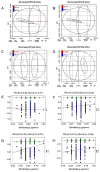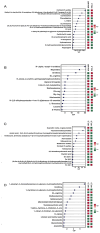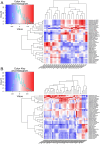Integrated analysis of serum metabolomics and fecal microbiome in infants with necrotizing enterocolitis
- PMID: 40539103
- PMCID: PMC12176818
- DOI: 10.3389/fmicb.2025.1584041
Integrated analysis of serum metabolomics and fecal microbiome in infants with necrotizing enterocolitis
Abstract
Background: Necrotizing enterocolitis (NEC), a lethal gastrointestinal disorder in preterm infants, remains poorly understood in its pathology, and early diagnosis are critically limited. Multi-omics approaches present unprecedented opportunities to elucidate NEC pathogenesis and identify clinically translatable biomarkers.
Methods: Infants with Bell stage II-III NEC and gestational age-matched controls were enrolled. Serum/stool samples from NEC patients at acute (NEC-D) and recovery (NEC-R) phases, and controls (non-NEC) were collected. Fecal metagenomic sequencing and serum untargeted metabolomic profiling were performed. Clinical parameters were compared.
Results: The study comprised seven NEC and seven non-NEC infants. Baseline neonatal characteristics and maternal perinatal parameters showed no significant differences between NEC-D and non-NEC except for markedly lower leukocyte counts in NEC infants. Fecal metagenomics revealed severely diminished alpha diversity in NEC-D versus both non-NEC controls and NEC-R, characterized with lower Chao1 index. NEC-D exhibited elevated Escherichia coli relative abundance alongside reduced Staphylococcus haemolyticus, Staphylococcus aureus, Staphylococcus epidermidis, and Lactobacillus paracasei. Correspondingly, KEGG functional gene analysis demonstrated impaired metabolism in NEC-D. Serum metabolomics identified significantly decreased ornithine, DL-arginine, L-threonine, leucine, and D-proline in NEC-D versus non-NEC. NEC-D also showed lower taurodeoxycholic acid, glycocholic acid, and chenodeoxycholic acid compared to NEC-R. Integrative analysis revealed a positive correlation between the metabolites D-proline and ornithine and the Lactobacillus paracasei, Staphylococcus epidermidis, and Staphylococcus aureus abundance.
Conclusion: NEC is characterized by gut microbiota dysbiosis with reduced diversity, altered functional gene expression, and disrupted host-microbiota metabolic crosstalk. The identified serum metabolite-microbiome correlations provide mechanistic insights into NEC pathogenesis and potential diagnostic biomarkers.
Keywords: metabolomics; microbiome; multi-omics; necrotizing enterocolitis; preterm infant.
Copyright © 2025 Lin, He, Mo, Liao, Feng, Kong, Zhu, Li, Tan, Su, Jia and Wu.
Conflict of interest statement
The authors declare that the research was conducted in the absence of any commercial or financial relationships that could be construed as a potential conflict of interest.
Figures




Similar articles
-
The Metabolome and the Gut Microbiota for the Prediction of Necrotizing Enterocolitis and Spontaneous Intestinal Perforation: A Systematic Review.Nutrients. 2022 Sep 18;14(18):3859. doi: 10.3390/nu14183859. Nutrients. 2022. PMID: 36145235 Free PMC article.
-
Intestinal dysbiosis in preterm infants preceding necrotizing enterocolitis: a systematic review and meta-analysis.Microbiome. 2017 Mar 9;5(1):31. doi: 10.1186/s40168-017-0248-8. Microbiome. 2017. PMID: 28274256 Free PMC article.
-
Severe anemia in preterm infants associated with increased bacterial virulence potential and metabolic disequilibrium.Pediatr Res. 2025 Jun;97(7):2415-2422. doi: 10.1038/s41390-024-03669-4. Epub 2024 Oct 22. Pediatr Res. 2025. PMID: 39438713 Free PMC article.
-
Arginine supplementation for prevention of necrotising enterocolitis in preterm infants.Cochrane Database Syst Rev. 2017 Apr 11;4(4):CD004339. doi: 10.1002/14651858.CD004339.pub4. Cochrane Database Syst Rev. 2017. PMID: 28399330 Free PMC article.
-
Longitudinal fecal microbiota and volatile metabolomics preceding necrotizing enterocolitis in preterm infants: a case-control study.Sci Rep. 2025 Mar 26;15(1):10419. doi: 10.1038/s41598-025-94692-w. Sci Rep. 2025. PMID: 40140438 Free PMC article.
References
-
- Dobbler P. T., Procianoy R. S., Mai V., Silveira R. C., Corso A. L., Rojas B. S., et al. (2017). Low microbial diversity and abnormal microbial succession is associated with necrotizing enterocolitis in preterm infants. Front. Microbiol. 8:2243. doi: 10.3389/fmicb.2017.02243, PMID: - DOI - PMC - PubMed
LinkOut - more resources
Full Text Sources

